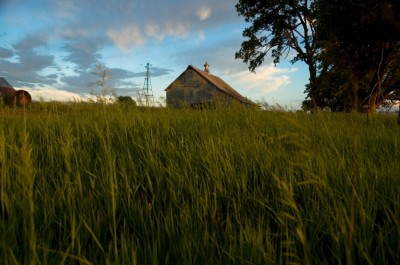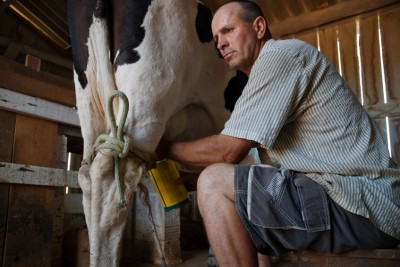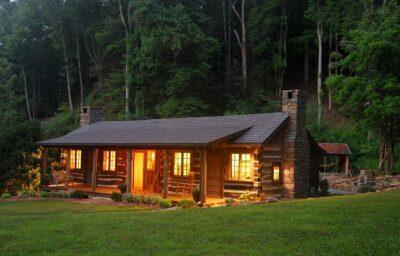Living off the grid with a significant degree of self-sufficiency appeals to many of us. I have numerous friends who have successfully left behind a life of mortgage payments, relentless bills and the trappings of materialism. I’ve even renovated a cabin and property that has been in the family for five generations to operate self-sufficiently, although it’s not yet my permanent residence.
What I learned from friends and my own experience made it clear that this is an undertaking that takes time and some “getting used to.” There can be a significant amount of culture shock if someone abruptly moves from an on-the-grid, dependent lifestyle to a life without easily accessible electricity, water and other necessities. It is a very labor-intensive lifestyle, so the time to learn new skills and to practice these skills is before you go totally self-sufficient.
In many ways, the six steps below are the tip of the iceberg when it comes to living self-sufficiently and off the grid. If you have already made the move or are planning for it, please feel free to offer advice, opinions, tips and your own experience to the comments section.
Before we begin, we need to define self-sufficiency. A self-sufficient lifestyle means you will produce many of the things you need that you customarily buy, use or take for granted. This includes:
- Food
- Water
- Building materials
- Heat
- Sanitation
- Clothing and bedding
- Furniture
- Medicines
- Cookware
- Tools
- Electricity
- Security
- Communication
When you consider this as a to-do list, the task can seem a bit daunting. Also, off the grid does not mean you are without electric power. It means you are not dependent on electricity from a power utility and may or may not produce your own power with solar panels or wind generators. The key is to start simple and try to determine how you can begin your first step toward self-sufficiency if that is a lifestyle you want to pursue. Some of these steps are practical, while others are more philosophical.
Step 1. Practice self-sufficiency
 Regardless of where you live or how you currently live, begin to practice self-sufficiency. Here are a few things to consider:
Regardless of where you live or how you currently live, begin to practice self-sufficiency. Here are a few things to consider:
- Plant a robust garden. This isn’t about a standard plot of tomatoes and cucumbers. This is a garden of significant size with a variety of vegetables that can seriously sustain a good amount of food for your table.
- Plant fruit trees in and around your yard instead of ornamental trees or trees simply for shade.
- Plant an herb garden that can take the place of many of the herbs you would customarily buy for cooking. Also, take the time to understand the medicinal value of certain herbs. In addition, many herbs like basil and mint are potent mosquito repellents.
- Replace traditional flowering plants and ground cover with plants that bear fruit or vegetables. Wild strawberries make an excellent ground cover, and many pepper varieties are as visually appealing as a flowering plant.
- Buy the equipment you need to begin home canning, and learn about various canning methods in addition to other food preservation techniques. Also, learn the preservation recipes using your growing bounty of homegrown fruits and vegetables.
- Start repairing instead of replacing. The ability to maintain and “fix it yourself” is a big step toward self-sufficiency, whether it’s tools, clothing, vehicles or simple appliances.
- Practice frugality. Learn to appreciate and value what you have, plan for what you need and resist the urge to simply acquire what you want.
Step 2. Determine how far you can go
Make a determination about how well your current home and property would allow for a fully self-sufficient, off-the-grid lifestyle. If you live in a city or suburb, you may have limits. It could be time to consider moving, or if you can afford it, think about adding a second home in a more effective environment for self-sufficiency that you will someday move into.
The Latest Breakthrough Advancement In Solar Backup Generators Is Here!
Property size defined by acreage is a key consideration even if there’s not a building currently on that property. And while you’re thinking about all of that, take the next steps.
- Consider adding a wood burning stove to your home to offer a supplement to your winter heating. Having access to an ample supply of firewood is critical, but if you do it’s definitely worth considering.
- Learn and practice the art of rustic furniture making. You can easily pursue this as a hobby, but someday the skills you develop could allow you to accomplish a significant amount.
- Begin to acquire the skills and the tools related to clothing from sewing to knitting. Once again, it’s easier to learn these skills before you find yourself in a labor-intensive, self-sufficient environment where your time for hobbies may be challenged a bit.
- Speaking of hobbies, if you’re not already an avid fisherman or hunter, you might want to consider taking those endeavors a bit more seriously. A big step toward self-sufficiency is your ability to acquire fish and game to supplement the gardens and orchards you will someday have.
Step 3. Learn new skills
 This is a bit of a crossroads for many people. While you can make simple changes to your lifestyle wherever you live, you have to consider your location and property size. If you think you may not be able to move or afford a second home or property for more ambitious steps toward self-sufficiency, this step may be your final one at moving toward a more self-sufficient lifestyle. It would include the following:
This is a bit of a crossroads for many people. While you can make simple changes to your lifestyle wherever you live, you have to consider your location and property size. If you think you may not be able to move or afford a second home or property for more ambitious steps toward self-sufficiency, this step may be your final one at moving toward a more self-sufficient lifestyle. It would include the following:
- Begin experimenting and learning about solar-generated power. Many states offer incentives for sustainable energy efforts like solar-generated power. Solar power equipment is also portable, so if you do relocate to a home that has a homestead capability with acreage and other resources, you can always take your solar panels and equipment with you.
- Think about expanding the size of your gardens to increase your production of fruits and vegetables.
- If you are going to make the move to a homestead location, begin to learn and understand some more ambitious, self-sufficient activities. If your municipality allows it, consider a chicken coop and a dozen chickens right now.
Other more robust things to learn about include:
- Field dressing and butchering livestock and game
- Advanced food preservation techniques
- Concepts and ideas related to water collection from hand pumps to Ram pumps, rain barrels, water-filtering and purification and large-volume, water storage.
- Timber frame construction and the tools you’ll need
- Other non-powered tools like whipsaws, complex axe configurations such as an adze, hand drills and scythes.
If you’re going to take the next steps to a homestead, collect, read and keep books on various subjects that you will continue to use as reference related to:
- Food preservation
- Butchering livestock and wild game
- Clothing and knitting patterns
- Medical, first-aid and alternative medicines
- Basic surgery
- Rustic furniture construction
- Maintenance manuals for critical vehicles, tools, and equipment
- Blacksmithing basics
- Edible wild plants
- Log Cabin and rustic small building construction
- Timber frame construction
- Livestock basics
- Leather working and leathercraft
- Shoe repair and cobbling
- Maple sugaring
- Beekeeping
- Juicing of fruit and vegetables such as apple cider, homemade vinegars, and other juices you can process and preserve
Step 4. Have a practice run – and expand your skills
This is a major step. If you currently live in a home on sufficient property in an area with good resources related to firewood, water, fishing and hunting, this step is logical.
The Best Source For Non-GMO Heirloom Seeds Is Right Here!
If you have acquired or are going to acquire property with a home, you’ll probably have to revisit previous steps with regards to planting fruit trees and outbuildings like a chicken coop or wood storage shed. It’s at this point you would be both expanding past efforts and adding new resource capabilities. This would include:
- The continued planting of fruit trees and other plants that provide edible foods such as raspberries.
- Expanding the gardens and developing compost areas in addition to seed collection for next year’s crop.
- Expanding the chicken coop and chicken yard and perhaps consider raising hogs, goats, or turkeys.
- Expanding your solar power capability, battery storage and 12V appliances.
- Surveying property for potential maple trees for maple syrup
- Serious stockpiling of firewood and woods for furniture making and home repairs such as wood shingles, siding and other repairs
- If you’re on the grid, it’s time to do some practice runs. Shut off the main power switch and go a few days off the grid. You’ll learn way more than any book or article can tell you about how self-sufficient you truly are. Also, make sure you close any gas valves, water valves and you don’t forgot to unplug appliances before you do this. When you switch the power back on, you will get a surge and you don’t want to burn out your refrigerator or discover the hard way that a gas-powered water heater was leaking gas without the relief of an electronic igniter that’s suddenly igniting again.
Step 5. Re-examine what you need
 At this point, it’s time to get serious. Up to now the previous steps have been about decision points to change the way you think, produce and use resources. Now it’s time to focus on making your production of resources sustainable. Here are some key things to think about:
At this point, it’s time to get serious. Up to now the previous steps have been about decision points to change the way you think, produce and use resources. Now it’s time to focus on making your production of resources sustainable. Here are some key things to think about:
- Sustainable water resources. A manual hand pump is a reliable source of water, but you need alternatives as well. Rain barrels are a possibility, but make sure you filter and purify water from rain barrels before drinking it. If you live next to or close to a spring, creek or river, you could use the current to power a ram pump but once again, be sure and filter and purify it. Many traditional homesteads had a cistern or other storage area in the basement below the kitchen where a kitchen hand pump provided water.
- Sustainable power. Now’s the time to take your knowledge of solar-generated power to the next level and determine how to store your generated power in a bank of six-volt or twelve-volt batteries. You might also consider a windmill generator to supplement the solar power.
- Upgrading your gardens to the degree that you can not only eat during the summer and early fall, but have enough for canning and preservation to get you through the winter.
- Digging a root cellar, or an area in the basement where you can store your preserved goods and learn how to store whole, root vegetables as well.
- Preserving fish and game, either through pickling, smoking or other techniques that will give you sustainable protein.
- Building your outhouse if you haven’t already, or find another alternative way to manage sanitation such as a compost toilet.
- Building your workshop where you will construct rustic furniture, do blacksmithing or shoe-cobbling and other projects that require specific tools and resources.
- Thinking about communication. It’s OK to have a solar charger for a mobile phone or computer. Self-sufficiency is not about self-denial, and certain devices like wireless phones are one of the few contemporary luxuries that also fall in the category of survival necessity. Some people choose HAM radio as another way to communicate. A rechargeable radio with AM and FM will let you know what’s happening even if it’s as simple as getting the weather forecast.
- Considering your nighttime lighting options, from candles to lanterns, to direct current lighting fixtures with LED bulbs, to rechargeable or hand-powered flashlights. There are also rechargeable batteries that can be recharged with solar panels. When you get to step six and you go off-grid, you’ll need them.
Step 6. Jump in
 It’s possible your homestead has already been off the grid from the beginning. In that case this step and previous steps are old news. But if you’re ready to take the big step to self-sufficiency for the first time, it’s time to disconnect and consider the following.
It’s possible your homestead has already been off the grid from the beginning. In that case this step and previous steps are old news. But if you’re ready to take the big step to self-sufficiency for the first time, it’s time to disconnect and consider the following.
- If you live in a part of the country where winters are harsh, you’ll want to make sure you have a sufficient stockpile of firewood, food and plans for renewable water resources. Ram pumps and manual pumps can easily freeze up in winter, so make sure you understand how to manage snow and ice or other water resources when the temperature continues below freezing.
- Think about your livestock and how well they will or won’t survive the winter months and what and when you will pull some hogs or chicken for butchering.
- Use the cold temperatures to your advantage for food preservation, but make sure any food canned in glass jars is in an area such as a root cellar, basement or pantry where they won’t freeze.
- If you live in a remote area where you have the potential to get snowed-in, make sure you have everything on hand to sustain yourself for a long duration.
There will be no lack of things to do, so make sure you have a routine and a schedule that will allow you to properly manage:
- Planting and harvesting of fruits, vegetables and seeds for next year’s crop. Don’t forget about weeding and mid-season planting.
- Regular collection and storage of firewood. Doing a little every day or at least every week will save you from the autumn panic, when homesteaders are usually at their busiest harvesting, canning, hunting, butchering and preparing for winter.
- New livestock from piglets to chicks beginning in spring and the regular feeding, cleaning and watering schedule in addition to egg collection and eventual butchering. This is a daily task.
- Maintenance of tools, equipment, house and other items. Some homesteaders pick one day a week called “maintenance day,” where they make a point of maintaining and repairing on a regular basis.
- Production and repair of clothing
The list, of course, will go on….
If you do get to the sixth step, congratulations. You’ve reached the highest level of self-sufficiency and self-reliance. And remember, too, that living off the grid in a self-sufficient way dos not mean that you have shunned society. In fact, you’ll find that you depend more and more on friends and neighbors for collective help with major projects, borrowing or lending tools or equipment, bartering everything from maple syrup to eggs, and simply sharing time and advice together.
You’ll also appreciate going to the to town from time to time unless you’ve figured out a way to refine gasoline for your chain saw, or have successfully learned how to perform an appendectomy. Regardless, you’ve made a decision to take more control of your life and no matter how far you move toward self-sufficiency, each step should take you closer to a happier and healthier life.
What advice would you give someone who is considering going off grid? Share your advice in the section below:
Discover The Trick To Saving Thousands At The Grocery Store. Read More Here.
 Off The Grid News Better Ideas For Off The Grid Living
Off The Grid News Better Ideas For Off The Grid Living





